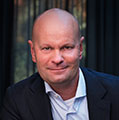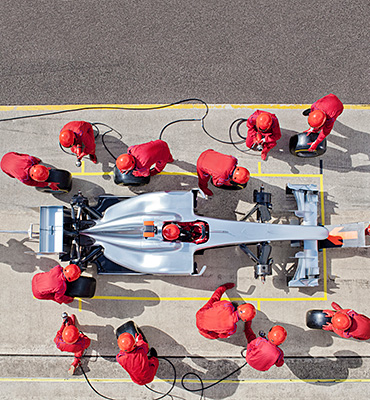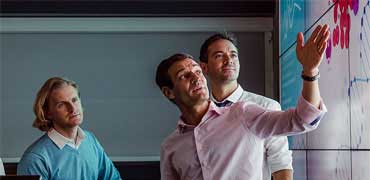Signify leads the way with multi-cloud
The fifth Leading lights boardroom featured insights on multi-cloud strategy from Kurt de Ruwe, CIO at Signify.

In the latest session of the Leading lights boardroom programme, enabled by CIO Magazine and BT, CIO Kurt de Ruwe described Signify's multi-cloud approach to digital transformation.
Signify, formerly Philips Lighting, provides products and services in the field of lighting for businesses and consumers. The past few years have been characterised by a transition from conventional lighting to LED, increasingly supported by intelligent platforms. The company is in the midst of a digital transformation, which as de Ruwe explained, was made possible by a corresponding cloud transformation.
Supporting accelerated cloud adoption
Our CTO, Colin Bannon, opened the session by observing how large organisations are migrating to the cloud even faster than they expected: “The internet is now the network, the cloud is the data centre, and every device is a device to work on.” In addition, he noted that identity is the new perimeter, a development accelerated by working from home during the pandemic. However, when it comes to networking, even the most modern SD-WAN is not specifically designed for the cloud, and so it is unable to provide the desired user experience.
Rehost, re-platform, rebuild
Colin outlined three movements in organisations transitioning to the cloud: rehost - optimising the infrastructure and eliminating shadow IT; re-platform - moving legacy applications to containers; and rebuild - rebuilding applications as microservices. Virtual machines are being moved to co-location, or even migrated to the native cloud, and network and security facilities are moving to carrier-neutral environments. He explained, “we are seeing the emergence of regional networks, which provide hubs to carrier-neutral facilities for SD-WAN and remote users. This bypasses the security controls in the data centre. Secure Access Service Edge, or SASE, is a concept that meets this need. It will be expanded to include CAS, web-based single sign-on for web applications.”
Configuring instead of developing technology
Next, Kurt de Ruwe took over the discussion. He described how the team at (what was then) Philips came to realise that the various business units would perform better separately. This led to the group’s division in 2014 and the birth of Philips Lighting. Kurt explained that the IT environment at the time was characterised by more functionality than required, and so costs were higher. To deal with this Signify, as Philips Lighting is now called, took a number of transformative steps including ‘application rationalisation’, reduction of the number of data centres, and systematic use of the cloud as a platform for hosting and development. De Ruwe maintained that Signify is now focused on the cloud in every way possible. For example, it has no WAN, but chooses the internet. It also opts for standard solutions wherever possible and works on the principle of 'configuring instead of developing'. In terms of cybersecurity, emphasis lies on protecting data and applications and no longer on the increasingly porous perimeter.
The benefits of multi-cloud
Kurt explained how and why Signify opted for a multi-cloud strategy: “Once you start using specific capabilities of a particular cloud, it's hard to get out of it. With a multi-cloud set up we can remain at a 'higher' level, which allows us to move applications between AWS and Azure quite easily." In the case of business IT, like the Signify platforms Interact and Hue, it would be much harder to migrate, if only because of the enormous amount of data involved. So, Signify use joint innovation to get more value out of the platform, looking at the volumes, and on that basis negotiating a new price. Kurt highlighted the importance of cost, noting that cloud is not always the cheapest platform for everything.
Ongoing transformation
Signify’s IT transformation does not stop there though. The team recently decided to adopt DevOps throughout the entire IT organisation. Together with BT, Signify are switching to SD-WAN and then also to SASE. The pace of change is evident from the number of projects in the digital sphere, which is now three times higher than last year.
Returning to the multi-cloud theme, Kurt de Ruwe advised leaders to determine what they wanted the cloud to be used for: for development or as a platform for running applications, and then take a good look at the architecture and data flows. “After all, you don't want any unnecessary data flows from one cloud to another, or from a data centre to a cloud in another country.” What’s more, cybersecurity is essential. He also emphasised that Signify's cloud journey has no final destination: "Every month we try new things and make adjustments."
Encryption and science fiction
Kurt put an interesting question to the CIOs present at the session: "End-to-end encryption in the entire network does not yet exist. Should this be the next step in protecting our data and applications?” He highlighted that is a great challenge for BT’s Global unit too.
This is indeed a challenge, not just from an encryption perspective. It's also a challenge in terms of guaranteeing data flows to various clouds - and therefore the user experience. After all, those data streams are to some extent shielded from the network devices by the encryption. At BT we’re also looking at the emergence of quantum computers and the need to 'quantum-proof' encryption. We’re working with Toshiba on providing quantum data streams, whereby thanks to the principles of quantum mechanics we can always see when data streams have been viewed on the move. It's almost science fiction.

